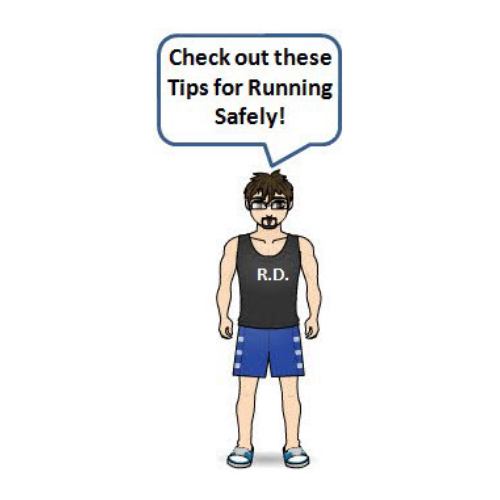RunnerDude's Tips for Running Safely

Keep running a safe and healthy activity. Read over the safety tips below, and then pass them along to a new runner. A great way to help him or her avoid learning the rules of the road the hard way.
Reflective clothing is a must for early morning and evening runs.
Up your weekly mileage by no more than 10% to prevent injury and to allow your body to gradually adapt to more miles.
Never run without telling a friend or family member your running route, your start time, and your expected return time. Better yet, post your weekly running schedule with routes and times on the  fridge so your family will know where you are.
fridge so your family will know where you are.
Never run without properly hydrating before, during, and after the run. On longer runs, drink 16oz 2hrs before, drink 6-12% every 15-20mins during, and after the run, drink 16oz for every pound lost.
Identification on your person is crucial if you’re ever in an accident. Make your own, or purchase a Road ID.
Never ignore pain. If pain doesn’t subside after RICE (Rest, Ice, Compression, Elevation), make it RICED by adding the “D”—diagnosis—and see your doctor.
Group Runs are one of the safest ways to run in the early morning or during the evening. Plus they're fun!
Stretching before and after a run is a good thing. Dynamic stretches like buttkicks, skipping, and walking lunges are best before the run and static stretches like calf stretches or toe touches are best for after the run.
Against-traffic-running is a must if you have to run on the road so you can see what’s coming.
First Aid and CPR training is a great idea, especially if you run in a group or with a buddy. If something happens, you can provide help immediately while waiting for EMS to arrive.
Eat to fuel your runs and for refueling after your runs. A high carb snack (~300cals) before the run and a post-run snack with a 4:1 carbs-to-protein ratio (e.g., lowfat chocolate milk).
Listen to your body. Over-training is one of the main causes of injury. Allow time for rest and recovery.
Yield to traffic. In most cases runners have the right-of-way, but better safe than sorry. Even if you have the right-of-way, never assume a driver is aware of your presence.

